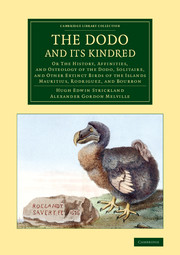
- Publisher:
- Cambridge University Press
- Online publication date:
- June 2015
- Print publication year:
- 2015
- Online ISBN:
- 9781139924405
- Subjects:
- History of Science, Life Sciences, Zoology, General Science

Well versed in natural history, particularly geology and ornithology, Hugh Edwin Strickland (1811–53) became fascinated by the dodo and mankind's influence on its extinction. Seeking to investigate this flightless bird and other extinct species from islands in the Indian Ocean, he invited the comparative anatomist Alexander Gordon Melville (1819–1901) to help him separate myth from reality. Divided into two sections, this 1848 monograph begins with Strickland's evaluation of the evidence, including historical reports as well as paintings and sketches, many of which are reproduced. Melville then analyses the osteology of the dodo and Rodrigues solitaire, describing his findings from dissections of the few available specimens and making comparisons with similar species. A seminal work, it correctly concluded that the dodo was more closely related to pigeons than vultures, and the book also inspired others to take up the search for new fossil evidence.
 Loading metrics...
Loading metrics...
* Views captured on Cambridge Core between #date#. This data will be updated every 24 hours.
Usage data cannot currently be displayed.